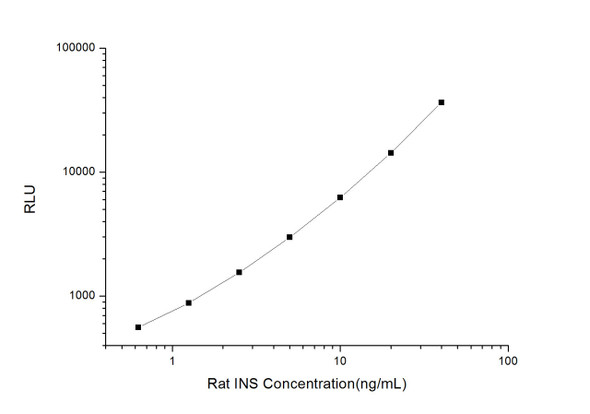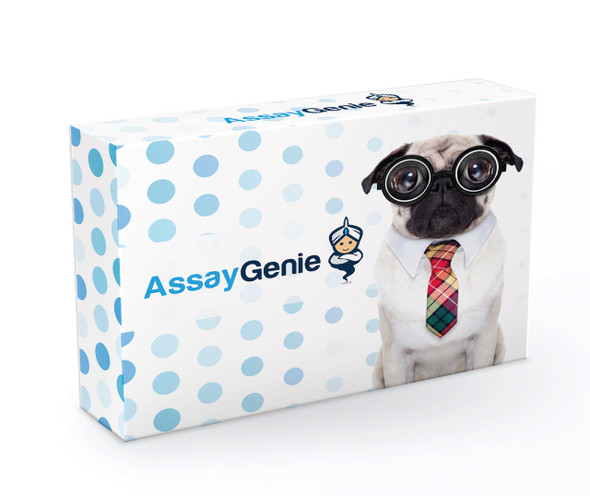Mouse Metabolism ELISA Kits
Mouse INS (Insulin) CLIA Kit (MOES00049)
- SKU:
- MOES00049
- Product Type:
- ELISA Kit
- ELISA Type:
- CLIA Kit
- Size:
- 96 Assays
- Sensitivity:
- 0.38ng/mL
- Range:
- 0.63-40ng/mL
- ELISA Type:
- Sandwich
- Synonyms:
- IDDM2, ILPR, IRDN, MODY10
- Reactivity:
- Mouse
- Sample Type:
- Serum, plasma and other biological fluids
- Research Area:
- Metabolism
Description
| Assay type: | Sandwich |
| Format: | 96T |
| Assay time: | 4.5h |
| Reactivity: | Mouse |
| Detection method: | Chemiluminescence |
| Detection range: | 0.63-40 ng/mL |
| Sensitivity: | 0.38 ng/mL |
| Sample volume: | 100µL |
| Sample type: | Serum, plasma and other biological fluids |
| Repeatability: | CV < 15% |
| Specificity: | This kit recognizes Mouse INS in samples. No significant cross-reactivity or interference between Mouse INS and analogues was observed. |
This kit uses Sandwich-CLIA as the method. The micro CLIA plate provided in this kit has been pre-coated with an antibody specific to Mouse INS. Standards or samples are added to the appropriate micro CLIA plate wells and combined with the specific antibody. Then a biotinylated detection antibody specific for Mouse INS and Avidin-Horseradish Peroxidase (HRP) conjugate are added to each micro plate well successively and incubated. Free components are washed away. The substrate solution is added to each well. Only those wells that contain Mouse INS, biotinylated detection antibody and Avidin-HRP conjugate will appear fluorescence. The Relative light unit (RLU) value is measured spectrophotometrically by the Chemiluminescence immunoassay analyzer. The RLU value is positively associated with the concentration of Mouse INS. The concentration of Mouse INS in the samples can be calculated by comparing the RLU of the samples to the standard curve.
| UniProt Protein Function: | Insulin decreases blood glucose concentration. It increases cell permeability to monosaccharides, amino acids and fatty acids. It accelerates glycolysis, the pentose phosphate cycle, and glycogen synthesis in liver. |
| NCBI Summary: | This gene encodes insulin, a peptide hormone that plays a vital role in the regulation of carbohydrate and lipid metabolism. The encoded precursor protein undergoes proteolytic cleavage to produce a disulfide-linked heterodimeric functional protein that is stored in secretory granules. An increase in blood glucose levels, among others, induces the release of insulin from the secretory granules. Mice deficient in the functional hormone encoded by this gene develop diabetes mellitus. Alternative splicing results in multiple transcript variants. [provided by RefSeq, Aug 2015] |
| UniProt Code: | P01326 |
| NCBI GenInfo Identifier: | 297374794 |
| NCBI Gene ID: | 16334 |
| NCBI Accession: | NP_001172012. 1 |
| UniProt Related Accession: | P01326 |
| Molecular Weight: | 12,364 Da |
| NCBI Full Name: | insulin-2 preproprotein |
| NCBI Synonym Full Names: | insulin II |
| NCBI Official Symbol: | Ins2 |
| NCBI Official Synonym Symbols: | Mody; Ins-2; InsII; Mody4; AA986540 |
| NCBI Protein Information: | insulin-2 |
| UniProt Protein Name: | Insulin-2 |
| Protein Family: | Insulin |
| UniProt Gene Name: | Ins2 |
As the RLU values of the standard curve may vary according to the conditions of the actual assay performance (e. g. operator, pipetting technique, washing technique or temperature effects), the operator should establish a standard curve for each test. Typical standard curve and data is provided below for reference only.
| Concentration (ng/mL) | RLU | Average | Corrected |
| 40 | 35858 37218 | 36538 | 36508 |
| 20 | 13743 14889 | 14316 | 14286 |
| 10 | 6724 5822 | 6273 | 6243 |
| 5 | 2918 3118 | 3018 | 2988 |
| 2.5 | 1692 1472 | 1582 | 1552 |
| 1.25 | 927 897 | 912 | 882 |
| 0.63 | 570 608 | 589 | 559 |
| 0 | 29 31 | 30 | -- |
Precision
Intra-assay Precision (Precision within an assay): 3 samples with low, mid range and high level Mouse INS were tested 20 times on one plate, respectively.
Inter-assay Precision (Precision between assays): 3 samples with low, mid range and high level Mouse INS were tested on 3 different plates, 20 replicates in each plate.
| Intra-assay Precision | Inter-assay Precision | |||||
| Sample | 1 | 2 | 3 | 1 | 2 | 3 |
| n | 20 | 20 | 20 | 20 | 20 | 20 |
| Mean (ng/mL) | 1.98 | 4.54 | 19.56 | 2.06 | 4.87 | 18.18 |
| Standard deviation | 0.21 | 0.48 | 1.25 | 0.17 | 0.52 | 2.00 |
| C V (%) | 10.61 | 10.57 | 6.39 | 8.25 | 10.68 | 11.00 |
Recovery
The recovery of Mouse INS spiked at three different levels in samples throughout the range of the assay was evaluated in various matrices.
| Sample Type | Range (%) | Average Recovery (%) |
| Serum (n=5) | 86-99 | 91 |
| EDTA plasma (n=5) | 99-115 | 107 |
| Cell culture media (n=5) | 97-113 | 103 |
Linearity
Samples were spiked with high concentrations of Mouse INS and diluted with Reference Standard & Sample Diluent to produce samples with values within the range of the assay.
| Serum (n=5) | EDTA plasma (n=5) | Cell culture media (n=5) | ||
| 1:2 | Range (%) | 94-108 | 102-115 | 99-115 |
| Average (%) | 101 | 108 | 107 | |
| 1:4 | Range (%) | 87-102 | 100-117 | 84-99 |
| Average (%) | 93 | 108 | 91 | |
| 1:8 | Range (%) | 84-98 | 103-117 | 101-112 |
| Average (%) | 90 | 109 | 106 | |
| 1:16 | Range (%) | 94-108 | 90-103 | 84-95 |
| Average (%) | 99 | 97 | 90 |
An unopened kit can be stored at 4°C for 1 month. If the kit is not used within 1 month, store the items separately according to the following conditions once the kit is received.
| Item | Specifications | Storage |
| Micro CLIA Plate(Dismountable) | 8 wells ×12 strips | -20°C, 6 months |
| Reference Standard | 2 vials | |
| Concentrated Biotinylated Detection Ab (100×) | 1 vial, 120 µL | |
| Concentrated HRP Conjugate (100×) | 1 vial, 120 µL | -20°C(shading light), 6 months |
| Reference Standard & Sample Diluent | 1 vial, 20 mL | 4°C, 6 months |
| Biotinylated Detection Ab Diluent | 1 vial, 14 mL | |
| HRP Conjugate Diluent | 1 vial, 14 mL | |
| Concentrated Wash Buffer (25×) | 1 vial, 30 mL | |
| Substrate Reagent A | 1 vial, 5 mL | 4°C (shading light) |
| Substrate Reagent B | 1 vial, 5 mL | 4°C (shading light) |
| Plate Sealer | 5 pieces | |
| Product Description | 1 copy | |
| Certificate of Analysis | 1 copy |
- Set standard, test sample and control (zero) wells on the pre-coated plate and record theirpositions. It is recommended to measure each standard and sample in duplicate. Note: addall solutions to the bottom of the plate wells while avoiding contact with the well walls. Ensuresolutions do not foam when adding to the wells.
- Aliquot 100 µL of standard solutions into the standard wells.
- Add 100 µL of Sample / Standard dilution buffer into the control (zero) well.
- Add 100 µL of properly diluted sample (serum, plasma, tissue homogenates and otherbiological fluids. ) into test sample wells.
- Cover the plate with the sealer provided in the kit and incubate for 90 min at 37 °C.
- Aspirate the liquid from each well, do not wash. Immediately add 100 µL of BiotinylatedDetection Ab working solution to each well. Cover the plate with a plate seal and gently mix. Incubate for 1 hour at 37 °C.
- Aspirate or decant the solution from the plate and add 350 µL of wash buffer to each welland incubate for 1-2 minutes at room temperature. Aspirate the solution from each well andclap the plate on absorbent filter paper to dry. Repeat this process 3 times. Note: a microplatewasher can be used in this step and other wash steps.
- Add 100 µL of HRP Conjugate working solution to each well. Cover with a plate seal andincubate for 30 min at 37 °C.
- Aspirate or decant the solution from each well. Repeat the wash process for five times asconducted in step 7.
- Add 100 µL of Substrate mixture solution to each well. Cover with a new plate seal andincubate for no more than 5 min at 37 °C. Protect the plate from light.
- Determine the RLU value of each well immediately.






